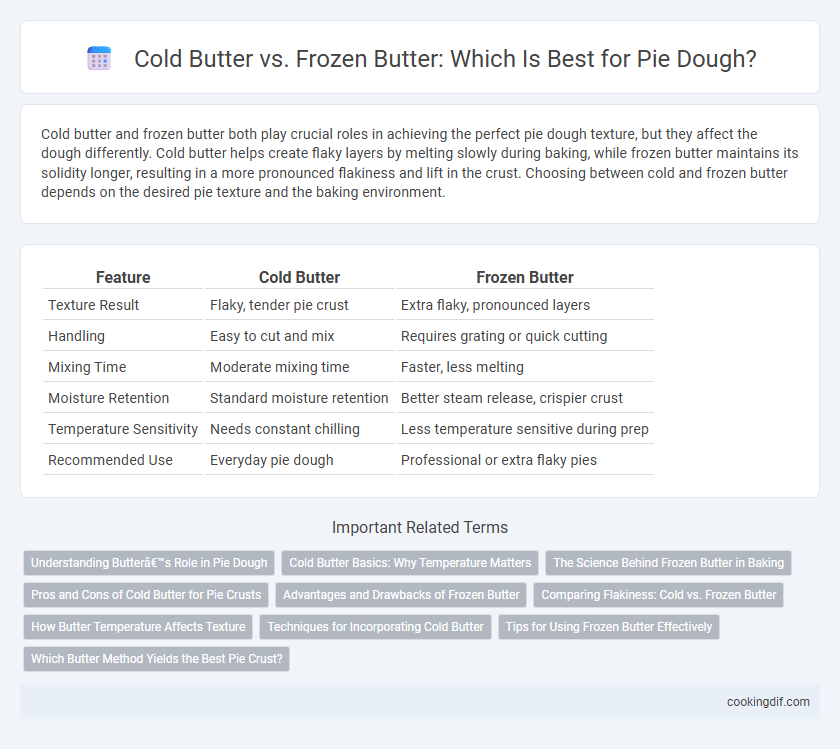Cold butter and frozen butter both play crucial roles in achieving the perfect pie dough texture, but they affect the dough differently. Cold butter helps create flaky layers by melting slowly during baking, while frozen butter maintains its solidity longer, resulting in a more pronounced flakiness and lift in the crust. Choosing between cold and frozen butter depends on the desired pie texture and the baking environment.
Table of Comparison
| Feature | Cold Butter | Frozen Butter |
|---|---|---|
| Texture Result | Flaky, tender pie crust | Extra flaky, pronounced layers |
| Handling | Easy to cut and mix | Requires grating or quick cutting |
| Mixing Time | Moderate mixing time | Faster, less melting |
| Moisture Retention | Standard moisture retention | Better steam release, crispier crust |
| Temperature Sensitivity | Needs constant chilling | Less temperature sensitive during prep |
| Recommended Use | Everyday pie dough | Professional or extra flaky pies |
Understanding Butter’s Role in Pie Dough
Butter's fat content and temperature significantly influence pie dough's texture, with cold butter creating a flakier crust by melting slowly during baking, forming steam pockets that lift the dough. Frozen butter, when grated or chopped finely into dough, provides even smaller fat pieces, enhancing flakiness and tenderness by producing more steam layers. Understanding butter's physical state helps optimize the balance between moisture and fat, crucial for achieving a crisp, tender pie crust.
Cold Butter Basics: Why Temperature Matters
Cold butter ensures the dough remains flaky by preventing premature fat melting, which helps create distinct layers during baking. Frozen butter offers similar benefits but requires precise handling to avoid overmixing and melting, which can toughen the crust. Maintaining low butter temperature is crucial for achieving tender, crisp pie dough with optimal texture and rise.
The Science Behind Frozen Butter in Baking
Frozen butter remains solid longer during baking, creating distinct layers in pie dough as it melts slowly, leading to a flakier texture. The slow melting enhances steam production within the dough, which puffs up the crust and prevents greasiness. This controlled melting aligns with the ideal fat temperature and distribution, essential for achieving optimal pie crust tenderness and structure.
Pros and Cons of Cold Butter for Pie Crusts
Cold butter for pie crusts ensures a flaky texture by creating steam pockets during baking, which helps to separate the dough layers. It is easier to cut into the flour, allowing for better control over dough consistency and preventing overworking, which results in a tender crust. However, cold butter can be more challenging to incorporate evenly compared to softer or frozen butter, potentially leading to uneven texture or pockets of butter in the dough.
Advantages and Drawbacks of Frozen Butter
Frozen butter for pie dough offers the advantage of maintaining a firmer texture during mixing, which helps create flakier layers by preventing premature butter melting. However, its drawback lies in the potential for uneven incorporation, leading to inconsistent dough texture if not handled carefully. This method requires a brief thawing period to achieve optimal pliability without sacrificing the cold temperature essential for a tender crust.
Comparing Flakiness: Cold vs. Frozen Butter
Cold butter creates flakier pie dough because it melts gradually during baking, forming distinct layers of steam that puff up the crust. Frozen butter tends to be harder to work with and may result in less even distribution, reducing the dough's ability to form crisp, flaky layers. Optimal flakiness comes from maintaining small, cold butter pieces that create steam pockets, which is more easily achieved with cold rather than frozen butter.
How Butter Temperature Affects Texture
Cold butter creates a flakier pie crust by releasing steam during baking, which forms distinct layers in the dough. Frozen butter, when grated or quickly incorporated, can also produce a tender texture but may result in slightly less defined flakiness compared to cold butter. Proper butter temperature controls gluten development and moisture distribution, directly impacting the pie dough's texture.
Techniques for Incorporating Cold Butter
Incorporating cold butter into pie dough ensures a flaky texture by creating layers of fat that melt during baking. Techniques include cutting the butter into small cubes to distribute evenly and using a pastry cutter or food processor to blend the butter just until pea-sized pieces remain. Keeping the butter cold prevents it from fully blending into the flour, which maintains the dough's structure and promotes a tender, crisp crust.
Tips for Using Frozen Butter Effectively
Using frozen butter for pie dough creates flakier crusts by releasing steam during baking, which helps form distinct layers. Cut the frozen butter into small, even cubes to ensure uniform distribution throughout the dough without melting prematurely. Handle the dough minimally and keep it chilled to maintain the butter's solid state for optimal texture and crumb structure.
Which Butter Method Yields the Best Pie Crust?
Cold butter creates a flakier pie crust due to its ability to release steam during baking, forming distinct layers. Frozen butter, when grated into the flour, offers better control over chunk size, contributing to a tender yet structured crust. Choosing between cold or frozen butter depends on desired texture, with cold butter favored for traditional flaky crusts and frozen butter enhancing ease of incorporation and crumbly texture.
Cold butter vs frozen butter for pie dough Infographic

 cookingdif.com
cookingdif.com